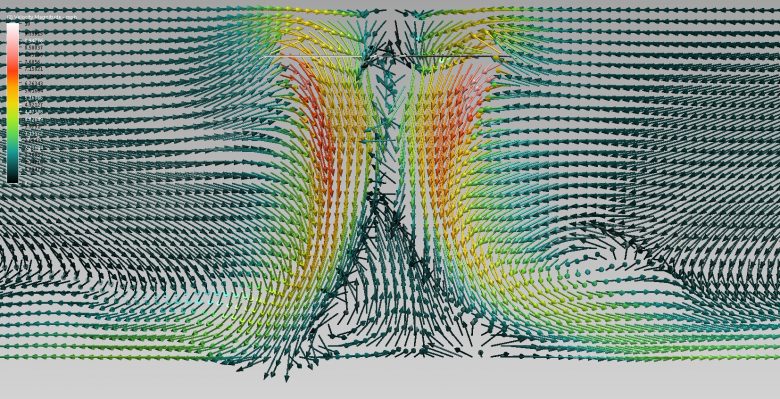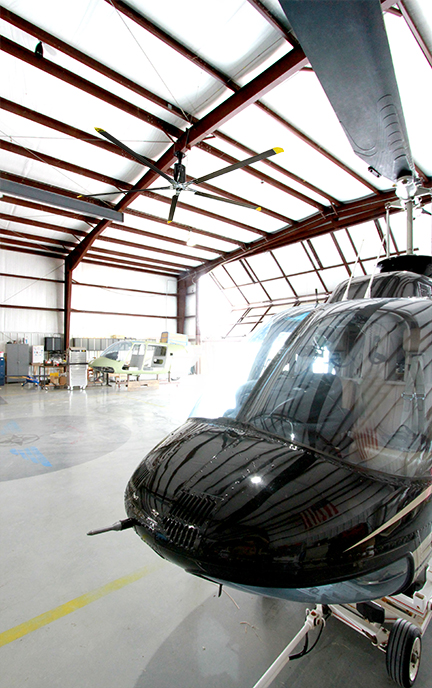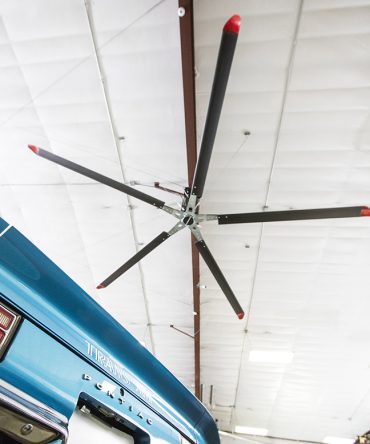Kelley industrial HVLS fans have a lot more in common with the well-known Sikorsky (Lockheed Martin) UH-60 Black Hawk helicopter than one might think.
In fact, the design for Kelley industrial HVLS fan blade winglets (blade tips) is a derivation of that used on the Black Hawk, the U.S. Army’s primary medium lift utility transport and air assault aircraft.
Prior to when Entrematic first started offering industrial HVLS fans in 2010, the company’s engineers began to closely examine helicopter blade design theory for its Kelley industrial HVLS fan blade profiles and winglets.

“Rather than reinvent the wheel (or blades, in this case), Entrematic took a careful look at what the top helicopter manufacturers—including Sikorsky and Bell Helicopter (Textron)—were doing,” says Richard Hoofard, Director of Engineering, Entrematic. “We simply asked ourselves, ‘Why and how are winglets being used on a rotary helicopter?’ and then took it from there.”
Hoofard explains that Entrematic was able to capitalize on his discoveries among Sikorsky’s existing intellectual properties, which included winglet design and blade profile patents. Although the patents had since expired and were freely available in the public domain, they were closely guarded at one time.

Goal: maximize fan blade functionality
“One major reason we decided to adopt Sikorsky’s downturned winglet design is that we wanted to maximize as much functionality as possible out of our industrial HVLS blades,” Hoofard points out.

The “why” behind the close connection between helicopters and industrial HVLS fans also centers on the concept that an industrial HVLS fan is essentially like a helicopter strapped to the roof of a building, but one that never moves. As the fan’s blades rotate, they provide lift similar to a helicopter’s rotary blades while pushing air downward.
In fact, Hoofard mentions that an industrial HVLS fan running at full speed actually weighs 100 lbs. less than when it’s not running. In other words, a warehouse ceiling from which a 258 lb. fan is hanging only experiences a weight of 158 lbs. when the fan is running at its highest speed setting. At that point, the fan is essentially generating 100 lbs. of lift.
In contrast with the symmetrical design of a helicopter blade that mechanically changes in pitch for lift and forward momentum, Kelley industrial HVLS fans rely on an asymmetrical blade design.
“Kelley industrial HVLS fan blades are biased to provide the most amount of lift at their intended lower rotational velocities (e.g. 58 RPM),” adds Hoofard. “Correspondingly, a helicopter blade obviously turns at a much faster RPM than an industrial HVLS fan.”
Although unrealistic, Hoofard relates that if an industrial HVLS fans did rotate at 600 RPM, it would undoubtedly generate a lot more air, but the fan wouldn’t be very efficient.
Vertical winglet design incorrect for rotary airfoils
He adds that various industrial HVLS fans on the market use vertical winglet designs akin to those found on commercial aircraft, designed for an airfoil that is traveling through relatively “clean air” (no turbulence) and in a straight line.
“Other fan manufacturers have opted to use different style approaches (similar to an aircraft’s vertical winglet design), but that’s not the correct approach for a rotary airfoil,” Hoofard emphasizes. “In fact, you could say those same HVLS fans would even perform better without their winglets.”
A Kelley industrial HVLS fan winglet is essentially a functional component designed to reduce vortices, similar to those seen emanating off the ends of commercial aircraft wingtips.
Caused by higher air pressure under the blade and much lower pressure on top of the wing, vortices are the result of displaced air that’s trying to reach the area of lowest pressure, thus causing the circular motion seen at the wings’ tips.
Blade ends generate the most lift
The vortices also cause aerodynamic (induced) drag, which means higher fuel consumption, and impact the amount of lift being generated. While not as critical on an airplane due to their minimal effects and relative size of the aircraft, the same can’t be said about vortices for a rotary helicopter airfoil.
For a helicopter’s rotary blades and industrial HVLS fans alike, the tip of the blade is the part that’s moving the fastest (farthest from the center) and where the most lift if generated. If vortices are allowed to develop, they negatively affect the amount of lift on the most important part of the blade system.
“Looking at an industrial HVLS fan as a helicopter that is always hovering and never moving, blades with no winglets will create vortices on each blade tip at blade height,” Hoofard explains. “This then causes air turbulence that each trailing blade must pass through, and as that repeatedly occurs, it compromises the fan’s overall efficiency.”
Hoofard says he’s found a lot of satisfaction in the one accomplishment that he and his engineering team were able to achieve with the Sikorsky-inspired winglet design: to push the turbulent (dirty) air and any vortices that do form under the industrial HVLS blades so that each trailing blade would then travel through undisturbed (clean) air.
“That,” Hoofard adds, “increases blade system efficiency, produces less drag and lowers energy consumption. In very simple terms, the fan will not have to work as hard to produce the same amount of air.”
